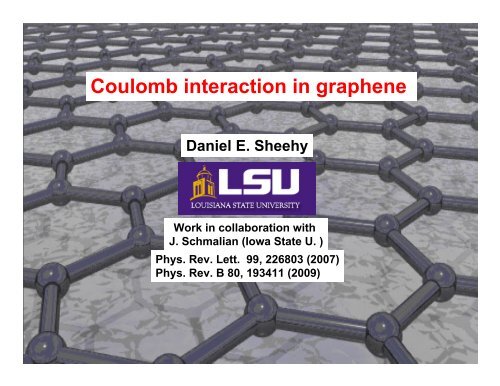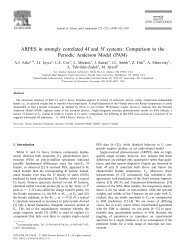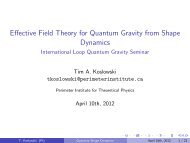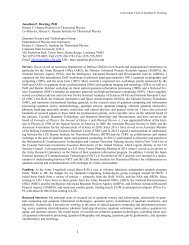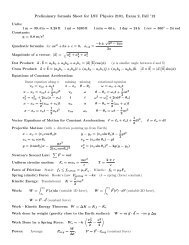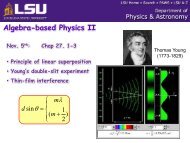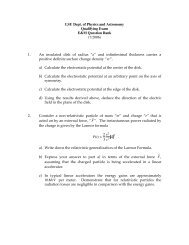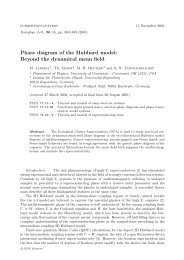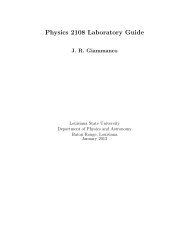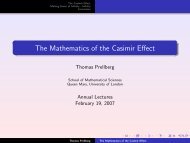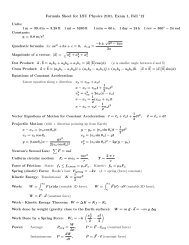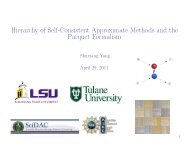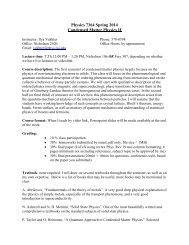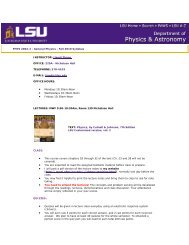Coulomb interaction in graphene
Coulomb interaction in graphene
Coulomb interaction in graphene
Create successful ePaper yourself
Turn your PDF publications into a flip-book with our unique Google optimized e-Paper software.
Outl<strong>in</strong>e• Graphene: One-atom thick sheet of graphite• Low-energy theory: <strong>Coulomb</strong>-<strong>in</strong>teract<strong>in</strong>g Dirac fermions• Theoretical research: Often neglects effect of <strong>Coulomb</strong> <strong><strong>in</strong>teraction</strong>sSee however:Gonzalez et al Nucl. Phys. B 94, ibid. PRB 99, Gorbar et al PRB 06,Khveshchenko PRB 06, Son PRB 07, Das Sarma et al PRB 2007, Vafek PRL 07,Barlas et al PRL 07, Biswas et al PRB 07, Hwang et al PRL 2007,…• Compute <strong><strong>in</strong>teraction</strong> corrections for several quantitiesRenormalization Group Hertz PRB 76, Millis PRB 1993Graphene: at a quantum critical po<strong>in</strong>t• Why are <strong><strong>in</strong>teraction</strong> effects negligible <strong>in</strong> optical transparency?Nair et al Science 2008
• K<strong>in</strong>etic energyLow-energy theory of <strong>graphene</strong>• Eigenvalues ! Energy bandsEk y!!a =1.42 Angstromk x• Two <strong>in</strong>equivalent nodes: L<strong>in</strong>ear dispersionEmpty!• Near nodes:E(k) " ±v | k |v = 3ta /2VelocityFilled!!!i =1,...4Sp<strong>in</strong>, node• Applies at low momenta:k
!Free fermions on the honeycomb lattice• “Relativistic” low-energy HamiltonianH = % †p,i" i(p)[vp# $]" i(p)Pauli matrices.• Condensed-matter phenomena:Photoemission, Infrared spectroscopyBostwick Nat. Phys 2007; Li Nat. Phys. 2008Novel Quantum Hall effect• “Relativistic” quantum field theory phenomena!Dirac fermions <strong>in</strong> B-fieldZhang et al Nature 2005Two-componentsp<strong>in</strong>orObserve v " c /300 Novoselov Nature 2005Zitterbewegung Katsnelson 2006“jittery motion” of Dirac fermions - uncerta<strong>in</strong>ty pr<strong>in</strong>cipleSchw<strong>in</strong>ger pair production Allor et al PRD 2008• What about <strong>Coulomb</strong> <strong><strong>in</strong>teraction</strong>?Unscreenedparticle-hole production <strong>in</strong> an electric field(No Fermi surface)Next: Full Hamiltonian
H =% †p,iFull Hamiltonian: <strong>Coulomb</strong>" + 1 i(p)[vp# $]" i(p)2e 2" d 2 rd 2 r' n(r)n(r')# r - r'!K<strong>in</strong>etic energy• Is the <strong>Coulomb</strong> <strong><strong>in</strong>teraction</strong> important?Dimensionless<strong><strong>in</strong>teraction</strong> strength!" = e2vh<strong>Coulomb</strong> <strong><strong>in</strong>teraction</strong>F<strong>in</strong>estructureconstant!n(r) =N# †i=1" QED= e2ch = 1137" i(r)" i(r)• Effective f<strong>in</strong>e structure constant!" = 300" ! QED# 2.2• Broken relativistic <strong>in</strong>variance:Interactions: photons at velocity c!Fermions: velocity v(Not small!)Next: Dimensional analysis
H =% †p,iDimensional analysis" + 1 i(p)[vp# $]" i(p)2e 2" d 2 rd 2 r' n(r)n(r')# r - r'!K<strong>in</strong>etic energy!• Usual 2-D electron gas: K<strong>in</strong>etic energyK<strong>in</strong>etic energy per particle:!<strong>Coulomb</strong> <strong><strong>in</strong>teraction</strong>E KE" # Fn " n 2!" p= p22mPotential energy per particle: E <strong>Coulomb</strong>" n n " n 3 / 2!n(r) =Interparticle spac<strong>in</strong>gN# †i=1" i(r)" i(r)Relative importance ofK<strong>in</strong>etic & <strong>Coulomb</strong>depends on density!• Low density:E <strong>Coulomb</strong> ! >> E K<strong>in</strong>eticWigner crystal• High density:!E <strong>Coulomb</strong>
H =% †p,iDimensional analysis 2" + 1 i(p)[vp# $]" i(p)2e 2" d 2 rd 2 r' n(r)n(r')# r - r'!K<strong>in</strong>etic energy• Dirac fermion case!n– Gas of density :<strong>Coulomb</strong> <strong><strong>in</strong>teraction</strong>E <strong>Coulomb</strong>" n 3 / 2!E K<strong>in</strong>etic" n 3 / 2n(r) =N# †i=1" i(r)" i(r)Relative importance ofK<strong>in</strong>etic & <strong>Coulomb</strong><strong>in</strong>dependent of n!• Interactions are marg<strong>in</strong>al!!– No typical length scale!Perturbations break this symmetry– Applied chemical potential:" F# 1 E F– Applied Magnetic field:l B" 1 B• T = 0 Quantum critical po<strong>in</strong>t!!Next: RG analysis near QCP
Prescription:2) Rescale momenta & fermion fieldsIterate:!Wilsonian renormalization groupSee also Gonzalez Nucl. Phys. B 94, Khveshchenko PRB 06,Son PRB 07, Herbut et al PRL 08, …1) Trace over states <strong>in</strong> a th<strong>in</strong> high-p shell:!!!Z = Trexp "#H[$(p),$(p)]"(p) =" =1/T" > (p)" < (p)" < (p) = Z #"(bp)! !!"! ""(b) =1+ 1 • Orig<strong>in</strong>al theory:!4 " lnbb =1Tb !!T(b) =1+ 1 "(b) #0 T(b)4 " lnb !3) New theory: same as orig<strong>in</strong>al, with new coupl<strong>in</strong>g & temperature!!• Increase b: Trace over high-momentaT• , growsRenormalized theory has small coupl<strong>in</strong>g and high temperature†[ ]" /b < p < "p < " /b!!!Partial trace…!k yEffective theory for"k x" < (p)Next: density
• Chemical potential scal<strong>in</strong>g:µ(b) =Electron density• Fermion density: adjustable via dop<strong>in</strong>g or external gate V g– Impose chemical potential!Intr<strong>in</strong>sic:Electron doped:!Hole doped:!!µ " V gµ = 0,n = 0 (No Fermi surface)µ > 0,n > 0µ < 0,n < 0(e Fermi surface)(h Fermi surface)Geim & Novoselov Nat. Mat. 2007µb1+ 1 4 " lnb Grows under RG!• Density scal<strong>in</strong>g relation:!n(µ,T,") = b #2 n(µ(b),T(b),"(b))What we wantIn renormalized system• Need: Choice for brenormalization condition!!"(b)smallT(b) largeNext: RG condition
• Graphene: critical po<strong>in</strong>t at!Renormalization conditionT = µ = B = n = 0Magnetic field• Relevant perturbations: Grow under RG, leave vic<strong>in</strong>ity of QCP– Term<strong>in</strong>ate RG flow when perturbation reaches UV scale (bandwidth)Electroniccompressibility" #1 = $µ$nAssumeµ
Compressibility at low T• F<strong>in</strong>ite density, low T: RG conditionn(b*) = n 0" a #2Renormalized densitylattice scale" #1 $ v% '!4 n 1+ & 4 ln n 0)( n*,+See Also: Hwang et al PRL 07n0 1015 ! 2# 4"cmFree Dirac FermionsLog correction depends on density!• Note: Result is alwaysLead<strong>in</strong>g-order…$v " v&1+ # % 4 ln(...) '(• Interactions: Alter velocity <strong>in</strong> n or T dependent way!–Log prefactors: NOT small) At low energies,velocity growsweakly parameter dependent!–Different experiments should measure dist<strong>in</strong>ct velocitiesNext: Recent exp’ts
Recent compressibility dataJ. Mart<strong>in</strong>, N. Akerman, G. Ulbricht, T. Lohmann, J. H. Smet, K. von Klitz<strong>in</strong>g,A. Yacoby, Nat. Phys. (2007)• Scann<strong>in</strong>g S<strong>in</strong>gle electron transistor: Locally measure" #1 = $µ$nSubstrate: Altersdielectric const." #1 $ v!" = e2#vh% '4 n 1+ & 4 ln n *0)( n ,+!Graphene <strong>in</strong> vacuum" = 0 Doesn’t fit….!!• Interactions necessary to understand data" = 5.5–Best fit• Difficult to observe ln(n) dependence!–Uncerta<strong>in</strong>ty <strong>in</strong> velocityNext: Heat capacity
• Two regimesF(T,",µ) = b #2!– Fermi liquid ( µ >> T )Metallic ! C " #TFree energy & specific heatC = "T # 2 F#T 2TT(b) F(T(b),"(b),µ(b))n" #%v 1+ $ 4 ln n (0' *& n )electron orhole F.S.• Scal<strong>in</strong>g:Vafek PRL 07!– Dirac ! liquid ( µ
Phase diagram: Crossover behaviorC " T 2log 2 T!C " !T• ashed l<strong>in</strong>e: Crossover between two regimesNext: Transparency
Aperture partiallycovered by <strong>graphene</strong>Optical transparency of <strong>graphene</strong>• Recent Experiments: Graphene nearly transparentNair et al, Science 2008: “F<strong>in</strong>e structure constant def<strong>in</strong>es visual transparencyof <strong>graphene</strong>”See also Kuzmenko et alPRL 2008 -- graphiteTransmittance: t = 97.7%1Measures conductivity <strong>in</strong>• Theory*: t(") =(1+ 2#$(") /c) 2 optical regime!!*Stauber et al PRB 2008Next: Are <strong><strong>in</strong>teraction</strong>s important?!
Optical transparency of <strong>graphene</strong>• Nair et al results: Consistent with non<strong>in</strong>teract<strong>in</strong>g Dirac Fermions!!!• Transmission!!0.980.97t0.96400t(") =!5006001(1+ #$ QED/2) 2! !!"(nm)• Question: Why can we neglect <strong>Coulomb</strong> <strong><strong>in</strong>teraction</strong>?!– No log prefactors <strong>in</strong>"(#)700!" 0= e24h“Universal”Ludwig et al PRB 94F<strong>in</strong>e structure constant!– Small perturbative correctionNext: Are <strong><strong>in</strong>teraction</strong>s important?!
• Kubo formula:Conductivity scal<strong>in</strong>g"(#,T) = 1 # j x(q,#) j x($q,$#)current-current correlatorq %0• Scal<strong>in</strong>g of!!!j µ(q,") : Constra<strong>in</strong>ed by a Ward identity Gross, Les Houches, 1975rj (q,") = b rj R(bq,"(b))"(b) = " T(b)exactT• Quantum field theory: No anomalous dimension of conserved currents• Conductivity scal<strong>in</strong>g:–Valid to all orders <strong>in</strong> perturbation theory!"(#,T,$) = "(#(b),T(b),$(b))No factor…!Next: Higher-order correction
• Scal<strong>in</strong>g: "(#,T,$) = "(#(b),T(b),$(b))Conductivity of clean <strong>graphene</strong>Previously:"(b) # 0<strong>in</strong> renormalized theory• Perturbation theory <strong>in</strong> renormalized:!"(#,T,$) % " 0(#,T) + $(b)" 1(#,T) + $(b) 2 " 2(#,T) + ...!• Low-T regime: "(b*) = v# "(b*) #!1+ " 4&)(" = e24h 1+ c 1# +!(( 1+ 1 +# ln v$ /%!( ) +' 4 *t<strong>in</strong>y correction forkeep…" # 0"ln( v$ /%)Herbut, Juricic, Vafek, PRL 08Mishchenko Europhys. Lett. 08; NOT small <strong>in</strong> optical range!• What ! is the coefficient ?!c 1Calculate some diagrams…!Next: Two different results!
Transparency:t(") =!!!Herbut, Juricic, Vafek:c 1=25 " 6#$ 0.51212!!!Conductivity of clean <strong>graphene</strong>0.980.97t0.96400!1(1+ 2#$(") /c) 2500!600• What is the source of this discrepancy?"(nm)!Kubo formula: "(#) = 1 !# Lim j (q,#) j (%q,%#)q $0 x x#"(#) = Lim q $0!!&)("(#) = e24h 1+ c 1$ +(1+ 1 +( $ ln( v% /#)+' 4 *700Mishchenko:Two ways to compute!19 " 6#c 1= $ 0.01212Almost <strong>in</strong>dist<strong>in</strong>guishable fromnon<strong>in</strong>teract<strong>in</strong>g resultVia polarization:!charge densityq 2%(q,#)%(&q,&#)Next: Polarization…
Polarization approach"(#) = Lim q $0#q 2%(q,#)%(&q,&#)Diagrams <strong>in</strong>perturbationtheory….!Density vertexSelf energyVertex correctionResult:– Diagrams separately f<strong>in</strong>ite forv" # $19 " 6#– Sum: c 1= $ 0.012 Mishchenko’s result12!(Almost <strong>in</strong>dist<strong>in</strong>guishable fromnon<strong>in</strong>teract<strong>in</strong>g result)!
Kubo formula approach"(#) = 1 # Lim q $0j x(q,#) j x(%q,%#)SimilarDiagrams…!Current vertexSelf energyVertex correctionProblem:– Diagrams separately divergent forv" # $– Sum is f<strong>in</strong>ite… depends on regulation!
Cont<strong>in</strong>uity:Ward Identity and conservation laws" # j + $%$t = 0DEFINE" = j 0andQ = (",q x,q y)Q µj µ(Q) = 0!Diagrams must satisfy!!Q µj µ(Q) j "(#Q) = 0at each order <strong>in</strong>!"<strong><strong>in</strong>teraction</strong>How to regulate divergent diagrams?!!Restrict momenta of Green functions:!!V ( p)Q µj µ(Q) j "(#Q) $ 0 Ward identity violated(simple to show!)!propagator!G( p,") # G( p,")$(% & p)Restrict ! momenta of <strong>Coulomb</strong> <strong><strong>in</strong>teraction</strong>: V ( p) " V (p)#($ % p)Q µj µ(Q) j "(#Q) = 0Ward identity preserved!G( p,")step functionConductivity has25 " 6#c 1= $ 0.51212c 1=19 " 6#12$ 0.012!!!Agrees with polarization approach….
Optical transparency: Best hope for observ<strong>in</strong>g <strong>Coulomb</strong>…• High frequency: Coupl<strong>in</strong>g&)(" = e24h 1+ c 1# +(1+ 1 +( # ln( v$ /%)+' 4 *!"(#)close to bare value!" # 2.2• Unfortunately:c 1" 0.0125Probably not observable!!Mishchenko : Europhys. Lett. 08!• Kubo formula: Sum of divergent diagrams depends on regularization• Restrict momenta <strong>in</strong> Green functionsViolates charge conservation• Restrict transferred momenta <strong>Coulomb</strong>• Modify <strong>Coulomb</strong>e 2r " e2r 1#$withObeys conservation" # 0 Obeys conservationPhys. Rev. B 80, 193411 (2009)!!Next: Conclud<strong>in</strong>g Remarks
Conclud<strong>in</strong>g remarks• Graphene: Dirac fermions with <strong>Coulomb</strong> <strong><strong>in</strong>teraction</strong> (Marg<strong>in</strong>al)– Interaction effects: Log corrections to free case (Dirac fermions)• Renormalization group: Scal<strong>in</strong>g equations for various quantities– Specific heat, compressibility, diamagnetic susceptibility, dielectricfunction, …– Interactions only renormalize velocity:• Optical transparency probes conductivitylarge!• We resolved discrepancy with earlier Kubo formula calculation!(Lead<strong>in</strong>g order)&)(" = e24h 1+ c 1# +(!1+ 1 +( # ln( v$ /%)+' 4 *– Regularization method must preserve conservation laws!"%v " v'1+ # ln v$ /T& 4!But[ ]c 1=(*)19 " 6#$ 0.01212Small correction!Mishchenko Europhys. Lett. 2008


